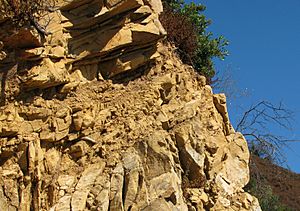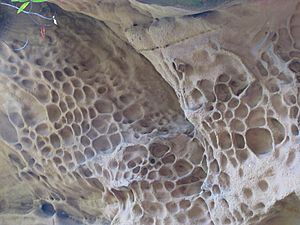Coldwater Sandstone facts for kids
Quick facts for kids Coldwater SandstoneStratigraphic range: Mid-Late Eocene |
|
|---|---|

Coldwater Sandstone, Santa Ynez Mountains, north of Santa Barbara, California
|
|
| Type | sedimentary |
| Underlies | Sespe Formation |
| Overlies | Cozy Dell Shale |
| Thickness | 0 to 3200 feet |
| Lithology | |
| Primary | sandstone |
| Other | siltstone, mudstone, occasional conglomerates |
| Location | |
| Region | Southern California |
| Country | United States |
| Type section | |
| Named for | Coldwater Canyon, tributary of the Sespe River, north of Fillmore |
| Named by | Watts(1896) |
The Coldwater Sandstone is a type of sedimentary rock found in Southern California. It was formed during the Eocene Epoch, which was about 56 to 34 million years ago. You can mostly find it in and around the Santa Ynez Mountains in Santa Barbara County and Ventura County.
This rock is mainly made of a type of sandstone called arkosic sandstone. It also contains some siltstone and shale. The Coldwater Sandstone is very strong and doesn't wear away easily. Because of this, it forms some of the most amazing landscapes in the Santa Ynez Mountains. You can see huge white rock slabs that create peaks, ridges, and steep cliffs.
Contents
What is the Coldwater Sandstone?
The Coldwater Sandstone gets its name from Coldwater Canyon. This canyon is a branch of the Sespe River, located north of Fillmore. Geologists study this area to understand the rock unit better.
The Coldwater Sandstone is usually about half a mile thick. In most places, it ranges from 2,500 to 3,200 feet thick. However, as you go west towards El Capitan State Beach, it becomes thinner, around 1,000 feet thick. Further west, near Gaviota, it slowly changes into a similar rock unit called the Sacate Formation. Both the Coldwater and Sacate Formations sit on top of another rock unit called the Cozy Dell Formation. Sometimes, geologists even consider the Coldwater and Sacate Formations as one big unit.
You can see the Coldwater Sandstone clearly on the southern side of the Santa Ynez Mountains. It also appears at the top of the range near San Marcos Pass. A tall peak called Cathedral Peak, which is 3,333 feet high, is part of the Coldwater unit. Since this sandstone is very strong, it forms unique ridges and slopes where the rock layers are tilted steeply. This kind of landscape is very common on the ridge north of Goleta. The Coldwater Sandstone makes up almost all the land above 1,000 feet there.
How Coldwater Sandstone Formed

The Coldwater Sandstone formed between 39.5 and 42.5 million years ago, during the middle to late Eocene Epoch. It was laid down in a shallow ocean environment. At that time, the sea was slowly getting shallower. However, this process wasn't always smooth. There were times when the water was very shallow, and other times when it was deeper. This is why the sandstone layers are mixed with layers of siltstone and shale. About 20% of the Coldwater Sandstone is made up of these finer materials.
Towards the end of its formation, large beds of oysters started to appear in the rock layers. This tells us that the area was becoming a brackish environment, meaning it was a mix of fresh and salty water, close to the shore. The sand and other materials that formed the Coldwater Sandstone mostly came from granitic rocks. You can even find small pebbles or cobbles of granite and quartzite in some of the sandstones closer to the top of the unit.
As the Coldwater Sandstone finished forming, it gradually changed into another rock unit called the Sespe Formation. The Sespe Formation is made of reddish rocks and conglomerates. It formed in a different environment, like a floodplain, riverine, or estuary (where a river meets the sea) on land.
How the Land Changed Over Time
Scientists have studied the Coldwater Sandstone to understand how the land has moved over millions of years. Using a method called magnetostratigraphy, which looks at the Earth's magnetic field recorded in rocks, they found out the age of the unit.
Studies also show that the large block of land where the Coldwater Sandstone is found, including the western part of the Transverse Ranges in California, has rotated almost 90 degrees clockwise since it formed. It has also moved north-northwest from its original spot. This idea is supported by other studies that found evidence of this big rotation in the Transverse Ranges.
In the last 2.5 million years, during the Quaternary period, the land has been pushed up by movements along the Santa Ynez Fault. This uplift has brought the Coldwater Sandstone and other rock formations to their high and visible locations in the Santa Ynez Mountains today. In some areas, like north of Santa Barbara and east towards Ojai, the squeezing and folding of the rocks have been so strong that the older rock layers are now on top of the younger ones. This area of flipped-over rocks is known as the "Montecito Overturn."
Ancient Life in the Rocks
You can find fossils of many different mollusks in the Coldwater Sandstone. Mollusks are a group of animals that include snails, clams, and oysters. Many types of sea snails from the genus Turritella are common, especially near the top of the formation. This is because the water was shallowest there when these creatures lived.
If you explore along Old San Marcos Pass Road above Goleta, or near where the Coldwater Sandstone meets the Sespe Formation, you might find many remnants of these ancient sea snails. In other places near the top of the unit, you can also find the remains of old oyster beds.


